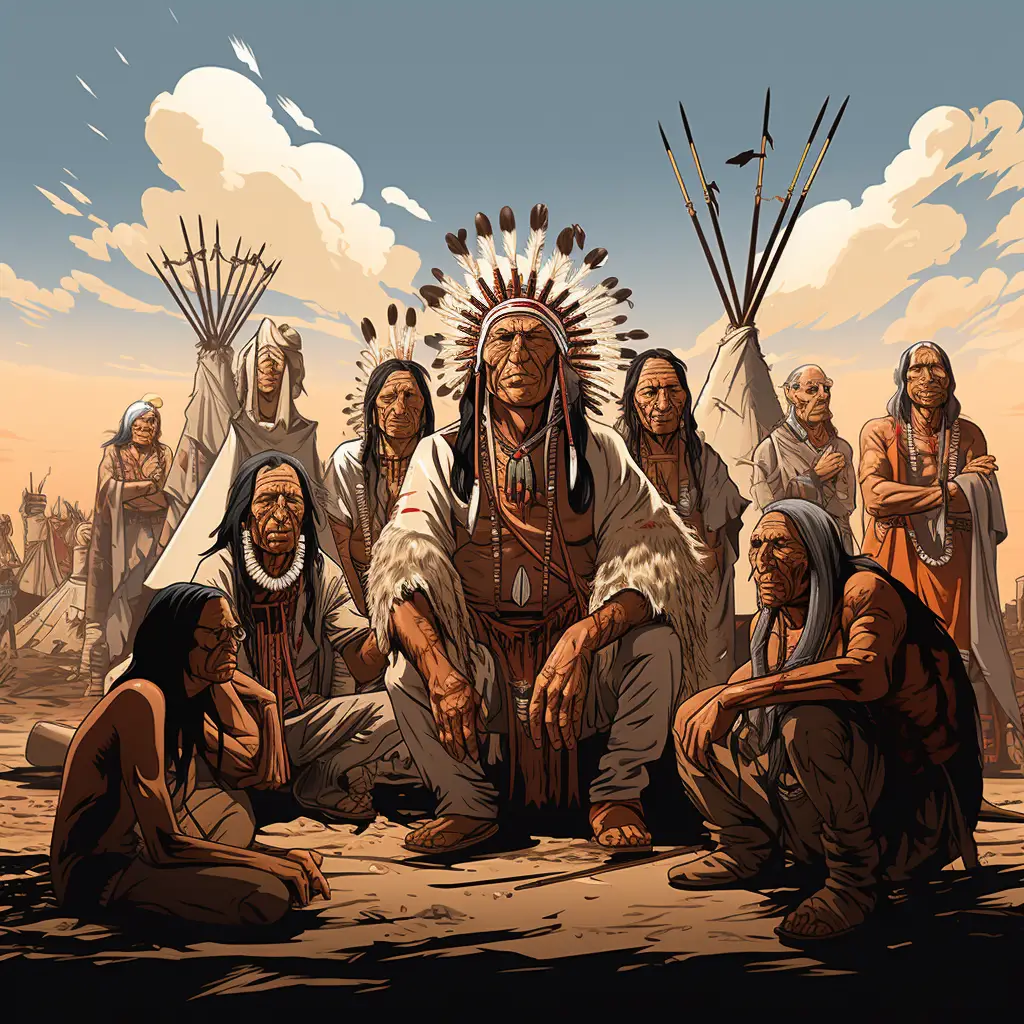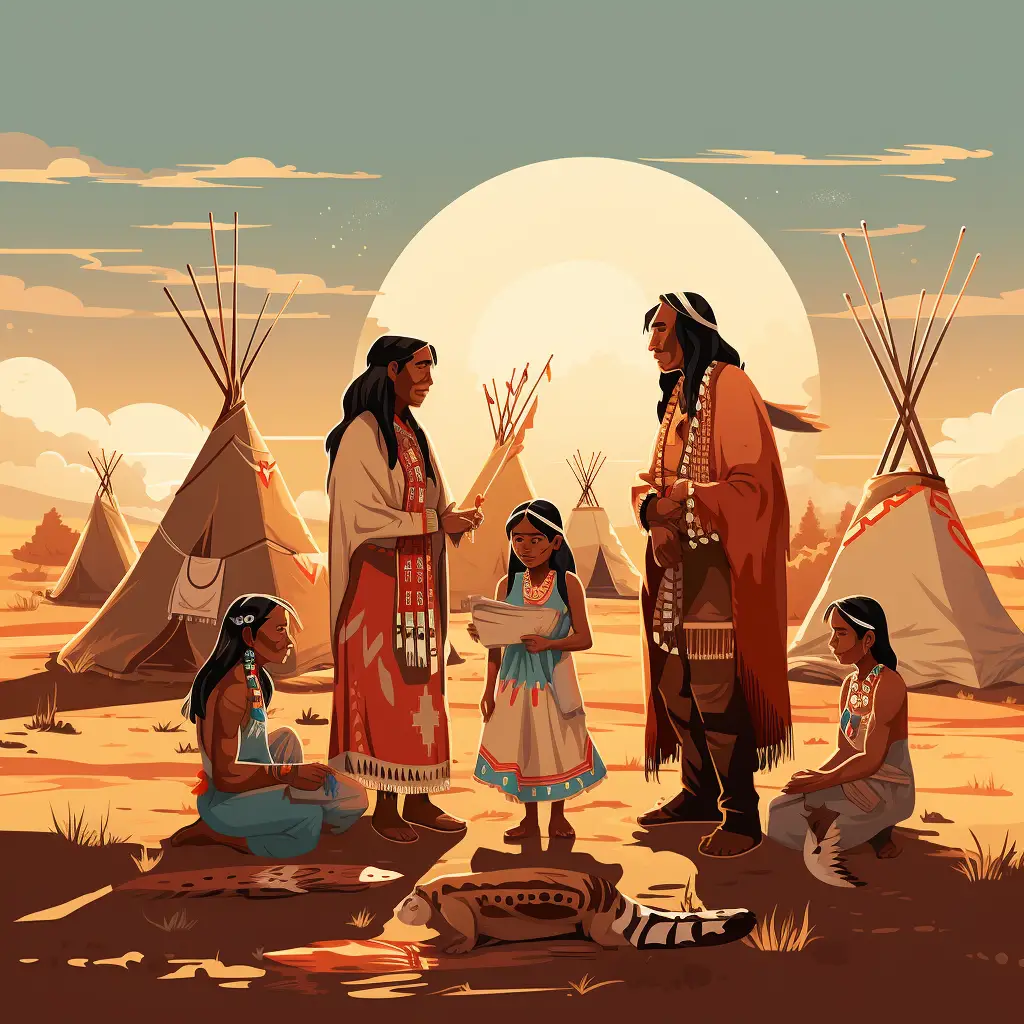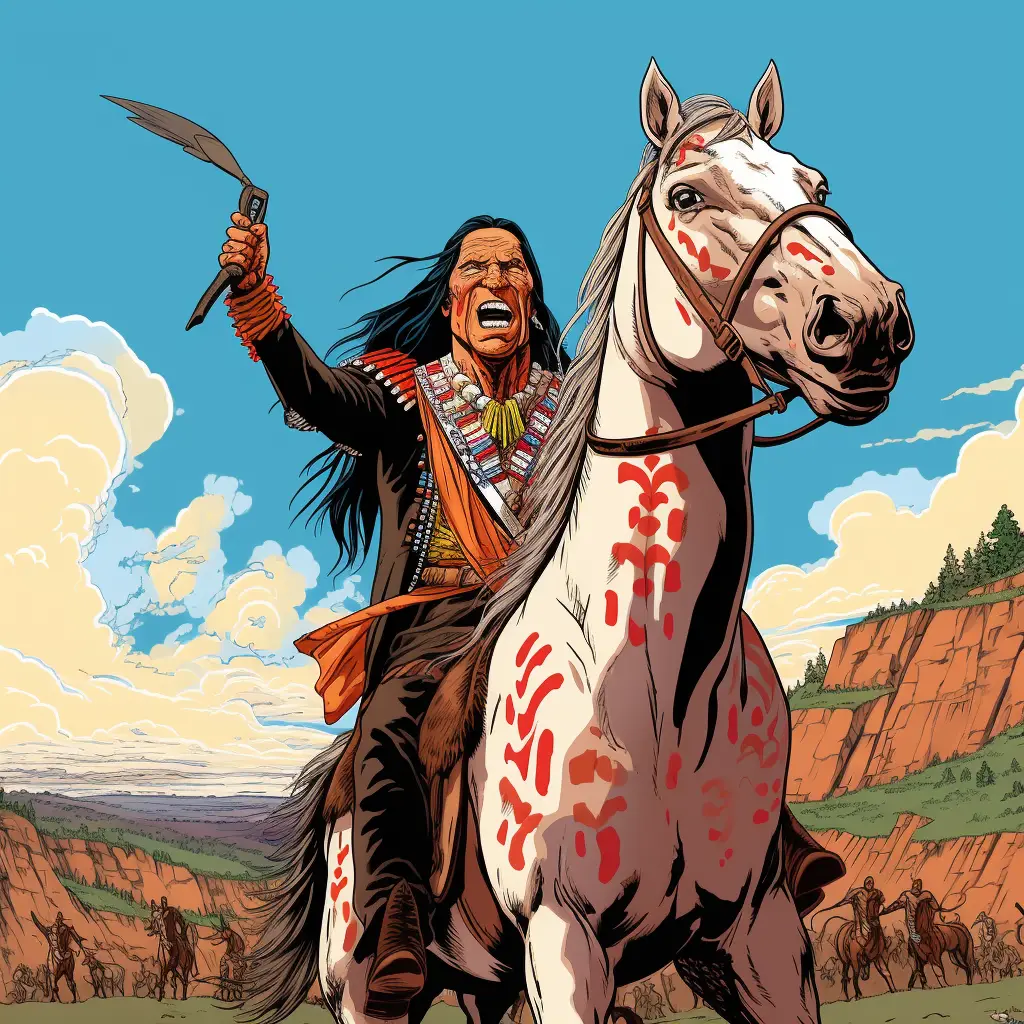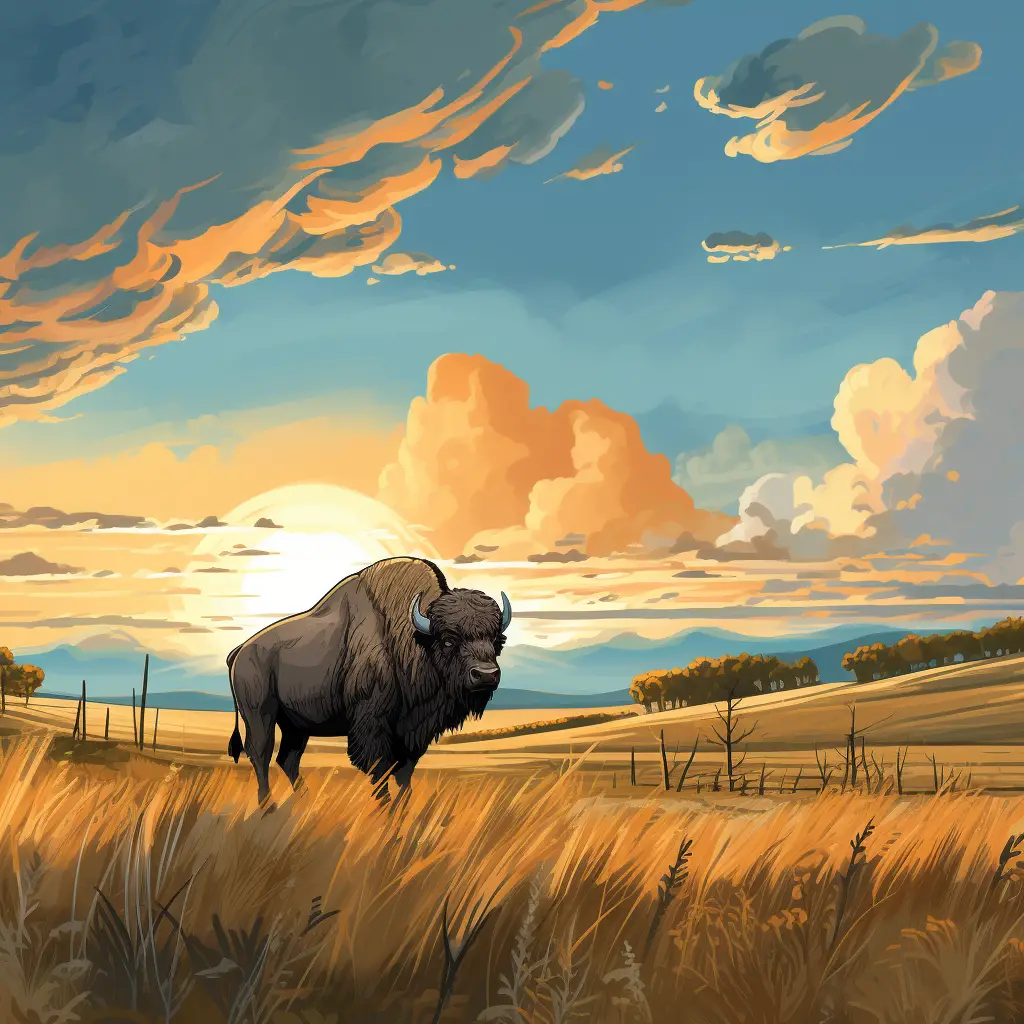Sioux Nation
Many people mistakenly assume that the Sioux (pronounced “soo”) are one tribe. They are actually three tribal bands that speak three dialects—the Lakota, Dakota, and Nakota. Of these, the Lakota are the largest and most well-known of the Sioux. They are also known as the Teton Sioux. Sioux leaders are among the most famous of all Native Americans. The three tribal bands are distinct not only because of their dialects but also because of their lifestyles.

Sioux Nation Facts For Kids
- The Sioux Nation is made up of three main tribes: Dakota, Lakota, and Nakota.
- They traditionally lived in the Great Plains region.
- Sioux people were hunters, especially of buffalo.
- The Sioux are known for their skill in horseback riding.
- They lived in tipis, which are cone-shaped tents.
- The Battle of Little Bighorn was a major Sioux victory.
- Sitting Bull and Crazy Horse were famous Sioux leaders.
- The Sioux have a rich oral tradition of storytelling.
- The Wounded Knee Massacre was a tragic event in Sioux history.
- Today, many Sioux live on reservations in the U.S. and Canada.
Plains Indians
The Sioux Nation, alternatively recognized as the Dakota, Lakota, or Nakota, is an integral component of the Plains Indians, a multi-faceted congregation of Native American tribes traditionally settled in the Great Plains region of North America.
Their nomadic lifestyle was heavily dependent on buffalo hunting, utilizing every facet of the animal from food and clothing to shelter and tools. In addition to this, the Sioux were noted for their complex social hierarchy and religious customs, such as the Sun Dance and vision quests, contributing to their rich cultural traditions.
Their exceptional mastery of horse riding and combat, combined with their profound cultural customs, established the Sioux as one of the most formidable and respected tribes among the Plains Indians.
Battle of Little Bighorn
The Sioux Nation, guided by their courageous leader Sitting Bull, were instrumental in the historically significant Battle of Little Bighorn, an event notorious for the defeat of the 7th U.S. Army Cavalry by an alliance of Native American tribes.
This confrontation was spurred by Sioux’s profound frustration and anger towards the incessant invasion by settlers on their sacred lands, compelling them and their Cheyenne and Arapaho allies to fiercely defend their ancestral territories and established lifestyle.
The consequential triumph of the Native Americans in this battle has subsequently become an emblem of indigenous resistance against Western encroachment.
Lakota, Dakota, and Nakota Nations
The Sioux Nation, a complex confederation celebrated for its vibrant cultural heritage, comprises primarily the Lakota, Dakota, and Nakota nations. Despite these nations sharing common linguistic and cultural roots, they each boast unique characteristics and historical experiences.
A significant part of their distinction comes from the Lakota who are renowned for their historical resistance against U.S. expansion in the American West. Conversely, the Dakota were primarily nestled in the Minnesota River Valley, where they pursued more agricultural practices.
The Nakota, often recognized as the Yankton or Yanktonai Sioux, initially resided in the eastern Dakotas, western Minnesota, and northeastern Nebraska. In the present day, these nations persist in preserving and promoting the cultural traditions and values of the Sioux Nation, thereby enriching the diverse tapestry of Indigenous cultures in North America.
Wounded Knee Massacre
In 1890, the Sioux Nation endured the notorious Wounded Knee Massacre, a monumental tragedy deemed as one of Native American history’s darkest periods. This horrific event unfolded on the Lakota Pine Ridge Indian Reservation in South Dakota, a region significantly inhabited by the Sioux Nation.
It was triggered when U.S. troops attempted to disarm tribe members, sparking chaos that led to the troops opening fire. The massacre claimed the lives of nearly 300 Sioux, including women and children, marking a heartrending period for the tribe and symbolizing the termination of Native American armed resistance to U.S. westward expansion.
Today, the Wounded Knee Massacre resonates as a powerful testament to the Sioux Nation’s resilience amid adversity, their relentless pursuit of justice, and the tenacity of their cultural heritage.
Native American Reservations

One of the most prominent and influential Native American tribes, the Sioux, has a strong presence within the sphere of Native American Reservations. The tribe extends across a variety of reservations located in North and South Dakota, Nebraska, Minnesota, and Montana, including the Standing Rock, Pine Ridge, and Cheyenne River Reservations.
These reservations act as crucial hubs for the Sioux, preserving their historical and cultural identity. However, the Sioux, like many other Native American tribes, grapple with a myriad of challenges on these reservations.
These include economic difficulties, erosion of their cultural identity, and ongoing battles for their rights and sovereignty. Yet, in the face of these adversities, the Sioux Nation continues to push for self-sustainability, retains its cultural heritage, and persistently fights for its ancestral lands.
American Indian Wars
During the intermittent conflicts known as the American Indian Wars, between European colonists and North America’s native peoples, the Sioux Nation emerged as a pivotal player.
Their involvement was particularly prominent in the Dakota War of 1862 and the Great Sioux War of 1876, wars fundamentally grounded in territorial disputes, cultural misunderstandings, and the desire for resources.
The Sioux, recognized for their intense warrior culture and deep spiritual practices, fiercely defended their lands, engaging in notable battles, including the Battle of Little Bighorn. However, despite their resistance and negotiation efforts, the Sioux, like many other tribes, encountered numerous hardships.
They suffered heavy casualties, were forcibly removed from their ancestral lands, and experienced significant disruptions to their lifestyle. Nevertheless, their influence and contribution to the American Indian Wars have left an enduring mark on U.S. history, underscoring their legacy.
Sitting Bull
The Sioux Nation, also recognized as the Dakota Nation, maintains an essential role in American history, primarily attributed to the influential leadership of Sitting Bull, a revered medicine man and chief of the Hunkpapa Lakota, one of the Sioux Nation’s tribes.
His uncompromising stance against the U.S. government’s encroachment on Native American territories is highly admired. The Battle of Little Bighorn in 1876, where Sitting Bull led his warriors to victory over the U.S. 7th Cavalry, remains a potent symbol of indigenous resistance.
While the Sioux Nation was eventually defeated and forcibly assimilated, the enduring spirit and resilience embodied by Sitting Bull’s defiance continue to serve as an inspiration to the tribe.
Crazy Horse

The Sioux Nation, especially the Oglala Lakota division, has a deep-rooted link to the fabled figure of Crazy Horse, a distinguished leader in the late 19th century celebrated for his unwavering commitment to preserving Lakota customs and territory.
His essential participation in significant conflicts like the Battle of Little Bighorn in 1876, where Sioux and Cheyenne’s warriors triumphed over the U.S. Army, underscores his importance. Crazy Horse’s zeal for his people’s sovereignty, tenacity amid hardship, and steadfast courage made him an enduring symbol of resistance against American encroachment on Native American lands.
Today, his revered place in Sioux Nation history remains, with his legacy immortalized in the massive Crazy Horse Memorial in South Dakota.
Ghost Dance Movement
In the late 19th century, during a period of intense conflict and tension between white settlers and the U.S. government, the Sioux Nation, especially the Lakota Sioux, was integral to the Ghost Dance Movement.
This was both a spiritual and political movement among Native American tribes. The Sioux believed in the Ghost Dance as a ritual that would bridge the gap between the living and the spirits of the dead, fostering peace, prosperity, and unity among the native peoples across the region.
Unfortunately, their involvement in the Ghost Dance Movement precipitated the Wounded Knee Massacre in 1890, where over 150 Sioux individuals, including men, women, and children participating in a Ghost Dance, were killed by the U.S. Army.
However, the Ghost Dance has endured as a significant symbol of cultural resilience and spiritual resistance for the Sioux Nation, despite its tragic history.
Treaty of Fort Laramie
The Sioux Nation also referred to as the Dakota or Lakota people, played an instrumental role in the 1868 Treaty of Fort Laramie, marking a pivotal moment in their history and the broader context of Native American rights and sovereignty.
Initiated by the U.S. government with the aim of ending Red Cloud’s War, negotiations were held with leaders of the Sioux, as well as other Plains Indian tribes. The outcome was the establishment of the Great Sioux Reservation boundaries and assurance of Sioux ownership over the Black Hills, a region they held sacred.
However, this treaty symbolizes a bleak period in Sioux history, as the U.S. government eventually breached its terms. This led to further conflicts, including the notorious Battle of Little Bighorn, underscoring the Sioux Nation’s continuous struggle for their rights and their land amid U.S. encroachments.
American Indian Tribes
Situated primarily in the northern Great Plains, the Sioux Nation was instrumental in shaping the cultural and historical landscape of North America. Despite the trials they faced during the European settlement, the Sioux have preserved their vibrant culture, contributing significantly to the rich tapestry of American Indian heritage.
Tribal Tattoo Design
Tribal tattoo designs of the Sioux Nation are reflections of their rich cultural heritage and spiritual beliefs. Often featuring symbols and imagery inspired by the natural world, these designs were traditionally used as rites of passage, talismans, or representations of personal achievements. Animals such as the eagle, buffalo, and bear, along with celestial bodies and geometric patterns, play central roles in Sioux tattoo artistry. Today, Sioux-inspired tribal tattoos are embraced worldwide, offering a tangible link to Sioux’s timeless tradition and profound connection to the earth and cosmos.
Indian Cultures
The Sioux Nation is a cornerstone of the diverse tapestry that comprises American Indian cultures. Their distinct Dakota, Nakota, and Lakota dialects, oral histories, ceremonial dances, and art forms such as quillwork and beadwork contribute significantly to the rich mosaic of Native American cultural traditions. The Sioux’s relationship with the earth, showcased in their belief systems and sustainability practices, is a testament to their profound spiritual connection with the environment. In the context of American Indian cultures, the Sioux Nation is both a unique entity and a common thread weaving through the broader cultural narrative.
Sioux Life
Lifestyle is deeply embedded in its spirituality, traditions, and respect for the natural world. From hunting buffalo on the Great Plains to crafting intricate beadwork, life within the Sioux Nation revolves around a communal ethos and a strong connection to ancestral lands. The Sioux embrace a cyclical view of time, with each generation learning the importance of bravery, fortitude, generosity, and wisdom from the last. In contemporary Sioux life, maintaining cultural traditions while navigating the complexities of modern society reflects their resilience and adaptability.
Sioux Artwork
Sioux Indian artwork is a vibrant manifestation of the tribe’s cultural heritage and spiritual beliefs. Traditional Sioux art is renowned for its exquisite beadwork, quill embroidery, and pottery, often incorporating symbolic patterns and depictions of the natural world. The buffalo, a key symbol in Sioux culture, frequently appears in their artwork. Contemporary Sioux artists continue these traditions while also exploring new forms and mediums, bridging the past with the present. Through their art, the Sioux Nation expresses its rich history, enduring resilience, and profound respect for the earth.
Bison Hide
The bison, or buffalo, holds significant cultural, spiritual, and material importance to the Sioux Nation. Bison hide was a crucial resource in Sioux life, providing materials for tipis, clothing, and tools. Artisans used the hide as a canvas for paintings and intricate beadwork that recorded tribal histories or spiritual visions. Bison hide shields also served as protective gear in battle. Today, bison hide continues to be a symbolic link to the Sioux’s traditional way of life, embodying their enduring connection to the natural world.
Beautiful Beadwork
The Sioux Nation is renowned for its intricate beadwork, an art form that embodies its cultural heritage and storytelling traditions. Utilizing a palette of colorful beads, Sioux artisans create designs inspired by the natural world, spiritual beliefs, and tribal history. From clothing and moccasins to bags and jewelry, this beadwork serves not only a decorative purpose but also a symbolic one. Each pattern tells a story or carries a message, making each beadwork piece a vibrant testament to Sioux’s rich cultural tapestry and artistic prowess.
Hunt Bison

The Sioux Nation’s hunting of the bison, or buffalo, was central to their traditional lifestyle and culture. These majestic creatures provided food, clothing, and shelter materials, making the hunt a communal and spiritually significant event. Skilled hunters, the Sioux used strategies that showcased their deep understanding of the bison’s behavior and the surrounding landscape. The hunt embodied a relationship of respect and interdependence between the Sioux and the bison. Today, the legacy of the bison hunt remains a potent symbol of Sioux heritage and their connection to the Great Plains.
From Snakelike Ones to Skilled Horsemen
The name “Sioux” originated in the 1600s, when French traders were told by an enemy tribe, the Ojibwas, that “Sioux” was their name. In the Ojibwa language, “Sioux” means “snakelike ones.”
The Ojibwas ultimately pushed the Sioux out of Minnesota and Lake Superior, forcing them to move westward. By the mid-1800s, the Lakota and Nakota were settled on the Great Plains, with the Dakota remaining largely in Minnesota. They were mostly nomadic people. They took advantage of the horses brought to North America by the Spanish and followed the buffalo westward. In time, the Sioux became expert horsemen.
The Flourishing Lakota and the Buffalo’s Plight
During the nineteenth century, the culture of Lakota, in particular, was flourishing. They were skilled buffalo hunters. The Great Plains was their home not only because of the buffalo but also because of their religious beliefs. The Lakota believed that they were created by the Great Spirit and emerged from a cave in the Black Hills region of South Dakota. This region is still sacred to the Lakota. It is more important to the Lakota than any other region.
It was also in the nineteenth century that conflicts between the Lakota and the United States government grew. The US built new military posts on the Plains to subdue tribes they considered hostile. As the white population increased, the buffalo population dropped. Settlers sometimes killed the buffalo for food, but often killed it for sport. (“Buffalo Bill” Cody is said to have killed more than four thousand buffalo himself!) With buffalo becoming nearly extinct in the mid- to late-1800s, the Lakota way of life suffered.
Fierce Warriors and Broken Promises
The growing conflict between the Sioux and white settlers led to three “Indian Wars.” During these conflicts, the Sioux earned a reputation as perhaps the most fearsome Native American warriors the US ever fought. In the first conflict, in 1854, nineteen US soldiers were killed. In retaliation, US troops killed almost one hundred Sioux in Nebraska in 1855. Red Cloud’s War in the 1860s resulted in a treaty that granted the Black Hills to the Sioux forever. Unfortunately, the US did honor the treaty and settlers continued to migrate into the area. When gold was discovered in the area, the number of settlers increased even more.
The final and deadliest conflict came in 1876. General George Custer’s entire force of three hundred troops (and Custer himself) was killed at the battle of Little Bighorn. After “Custer’s Last Stand,” the US government reacted quickly. The remaining Lakotas, including the fearsome warriors Crazy Horse and Sitting Bull, were forced to settle on a reservation.
Courageous Warriors and Cherished Families
In 1890, the Sioux suffered another terrible tragedy. At a site called Wounded Knee, on the Sioux reservation, US troops killed over one hundred men, women, and children.
The Sioux are remembered mostly for being fearsome fighters. But they were also very religious people who were devoted to their families. Children were considered sacred and cherished by their families.
Interesting Facts About the Sioux:
• As of 2014, more than $1 billion dollars is being held by the US Treasury for the sale of the Black Hills. The Sioux want the Black Hills returned and refuse to take the money.
• Along with Mount Rushmore, there is also a monument to Crazy Horse, the Sioux chief, in the Black Hills.
• George Custer and his troops were defeated by the famous Sioux chief, Sitting Bull.



